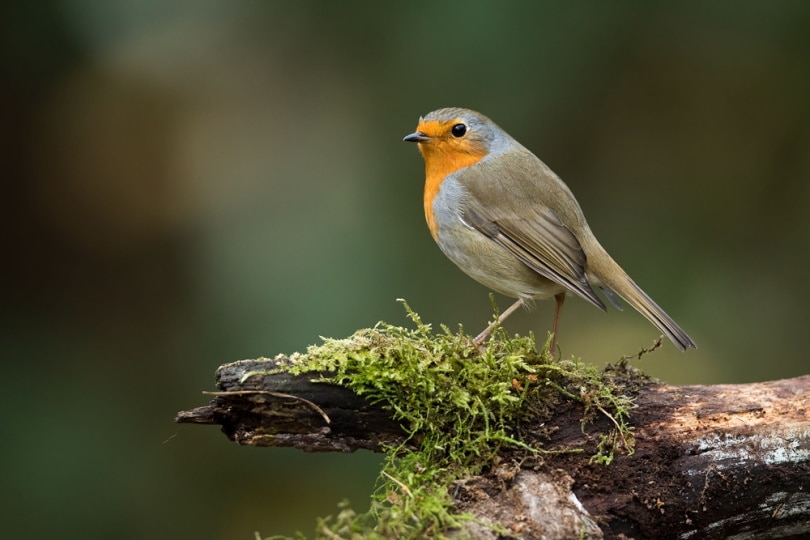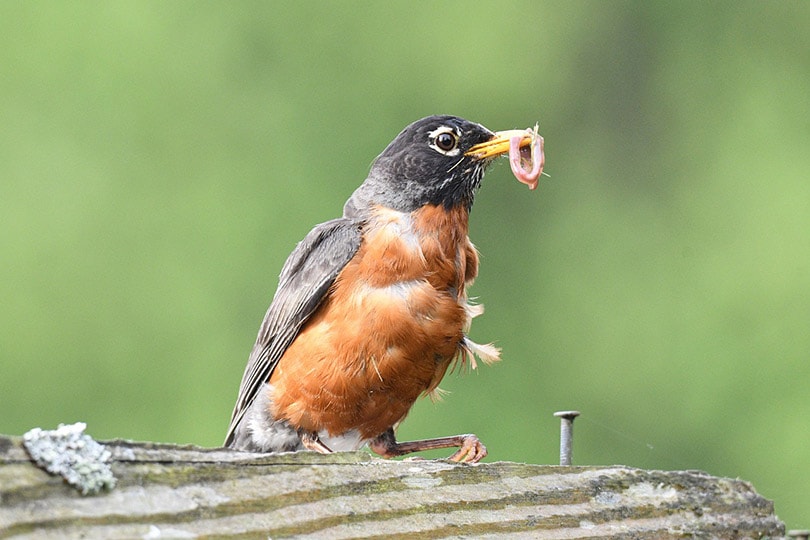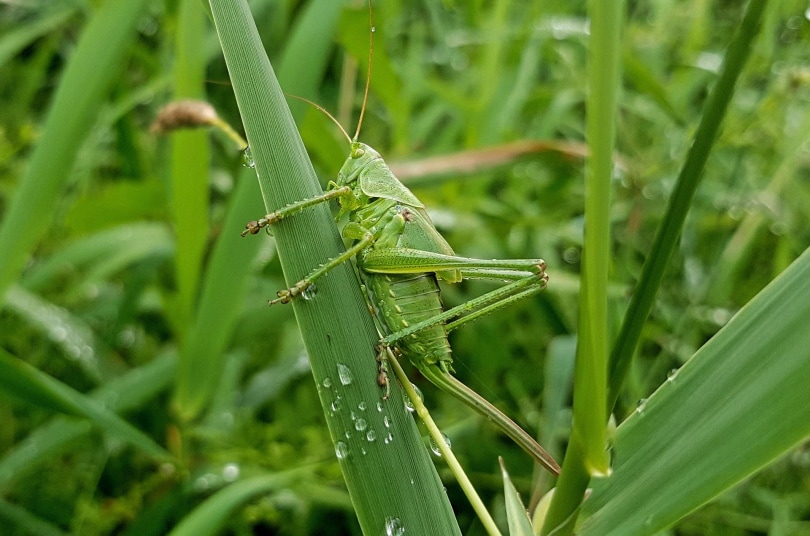What Do Robins Eat? 10 Typical Foods & What to Feed Them
Last Updated on

Robins are omnivores, and their diet primarily consists of meat and vegetables. They do have a preference, but for the sake of survival, they’ll adjust their diets from time to time. The two prime factors that often influence their dietary intake are food availability and seasonal changes.
They tend to consume a lot of protein-heavy meals during spring and summer and rely on vegetables during the cold season.

The 10 Typical Foods Robins Eat
Let’s start by looking at the foods that they often enjoy in the wild, before moving on to what you can feed them—if you’re hoping to make your backyard their permanent place of residence.
Wild Foods
1. Worms

Worms are an incredible source of protein, iron, and amino acids. They need the protein to act as a fuel source as they fight off infections, the iron to facilitate growth and development, and the amino acids for nutrient absorption, tissue repair, and protein synthesis.
2. Animals

If they feel like treating themselves to a better meal, they’ll prey on smaller animals including tadpoles, frogs, snakes, fish, chipmunks, and even other bird species.
They sometimes lose the fight, but it’s usually worth it. Because if they come out at the top, they end up having enough food to last them for days.
To increase their chances of winning, they’ll specifically target chicks, fledglings, and vulnerable babies. They’ll only go for the parent if the species is relatively smaller, or if they haven’t had a meal in a long while.
3. Insects

Robins love insects. They mainly feed on gypsy moths, dragonflies, Japanese beetles, lightning bugs, yellow jackets, and grasshoppers.
But that’s what we call “passive” hunting. Active hunting is most common during their breeding season when they are searching for food to feed their nestlings. For the young ones to develop strong bones and more muscles, they have to be fed protein-rich prey that’s small enough to be digested.
4. Eggs

We’re certain you guys have heard of species that prey on other birds’ eggs. Well, the robin is one of those species. Funny thing is, once they are done eating the contents of the eggs, the crushed shells become dessert.
This may sound strange, but nature has a way of letting birds know which types of meals are highly nutritious and wholesome. So, they’ll prey on the eggs, especially during winter when their food stores are running dry.
The eggshells are an incredible source of calcium—a mineral that the females desperately need during nesting, as they redistribute the little they have in their bones to ensure all eggs have a sufficient amount.
They’ll even eat some of their own eggs to extract the calcium at times.

Feeding Station Foods
The following are the different types of food to serve to lure more robins to your backyard:
5. Oatmeal

If you’re going to offer them oatmeal, don’t serve it cooked or even moist. This meal usually hardens to a rock-like consistency and could harm the bird.
And even raw, you’ll still have to take into consideration a couple of things. Take variety, for example. From our observations, the best varieties are instant and rolled oats. But don’t serve them every time, as they are high in iron, which can be hazardous to the bird. Speaking of minerals, oats are also high in calcium, magnesium, and vitamin A & B-6.
6. Sunflower Hearts

Just like most songbirds, robins love pecking away at sunflower seeds. Unfortunately, their bills aren’t always strong enough to break the shells. That’s why we serve them the hulled variety, otherwise known as the sunflower hearts. You could serve the hearts whole or crushed. But we prefer the crushed or kibbled ones, as those tiny pieces are easy to digest.
Sunflower hearts are a great source of proteins and healthy fats.
7. Suet

Suet can be mutton fat or beef fat that’s processed into tallow, which the birds love. It also contains protein and iron, but not enough to fulfill any robin’s dietary needs. That means you’ll have to serve it with something else, like sunflower hearts. Not separately, though. You should first heat it until everything melts, add the hearts, and then let it cool.
The best time to fill your feeders with suet is during winter. It’s a time when most birds frequently visit different gardens due to food scarcity.
8. Mealworms

Mealworms are the type of food that can be served anytime. If robins stumble upon your feeder and find mealworms served, they’ll call more of their friends, and make your backyard their permanent home.
And the good thing about mealworms is that they are usually packed in a dried form, making them easy to store. “Dried” doesn’t imply that they lack some or all of the essential nutrients required—they have everything that the bird requires to power through the freezing temperatures. That includes fiber, protein, and fat.
Before serving them, sprinkle a little bit of water on top to ensure they don’t turn to dust while the birds are trying to carry some. Also, only serve them if you’re totally sure that the birds are somewhere nearby. Because they easily go bad once they are exposed to moisture.
9. Peanuts

Have you ever seen any bird species that hates peanuts? The only reason why we don’t see them eat these fat-rich legumes too often is because the shells are too hard for them to crack. But if they could easily access the seeds, they’d eat peanuts 24 hours a day, 7 days a week.
If you’re too busy to crack the shells and crush the seeds into small bits, go for the kibbled peanuts. But don’t go for the salted variety, as sodium is harmful to the bird’s health. Also, seeing as peanuts are a staple in the squirrel community, you’ll have to buy a feeder that’s squirrel-proof.
10. Water

All wild animals need water just as we do. It’s instrumental in helping them control various body processes, including digestion. It also helps them to regulate their body temperature and stay hydrated in hot summers.

Conclusion
You should know robins love dog food as well. Just add a little water to whatever you serve it daily (to soften it) and leave a small portion outside, but not too often, more as a treat. The squirrels won’t touch it, and the birds will love you. Hopefully, you’ll find something on our list that’ll attract robins to your garden.
Featured Image Credit: WaceQ, Shutterstock
About the Author Robert Sparks
Robert’s obsession with all things optical started early in life, when his optician father would bring home prototypes for Robert to play with. Nowadays, Robert is dedicated to helping others find the right optics for their needs. His hobbies include astronomy, astrophysics, and model building. Originally from Newark, NJ, he resides in Santa Fe, New Mexico, where the nighttime skies are filled with glittering stars.
Related Articles:
What Is the Best Binocular Magnification for Hunting? Optical Features Explained
10 Types of Hummingbirds in Arkansas (With Pictures)
8 Types of Hummingbirds in Nebraska (With Pictures)
5 Types of Hummingbirds in Idaho (With Pictures)
3 Types of Hummingbirds in Mississippi (With Pictures)
8 Types of Hummingbirds in Kansas (With Pictures)
5 Types of Hummingbirds in West Virginia (With Pictures)
5 Types of Hummingbirds in Ohio (With Pictures)
